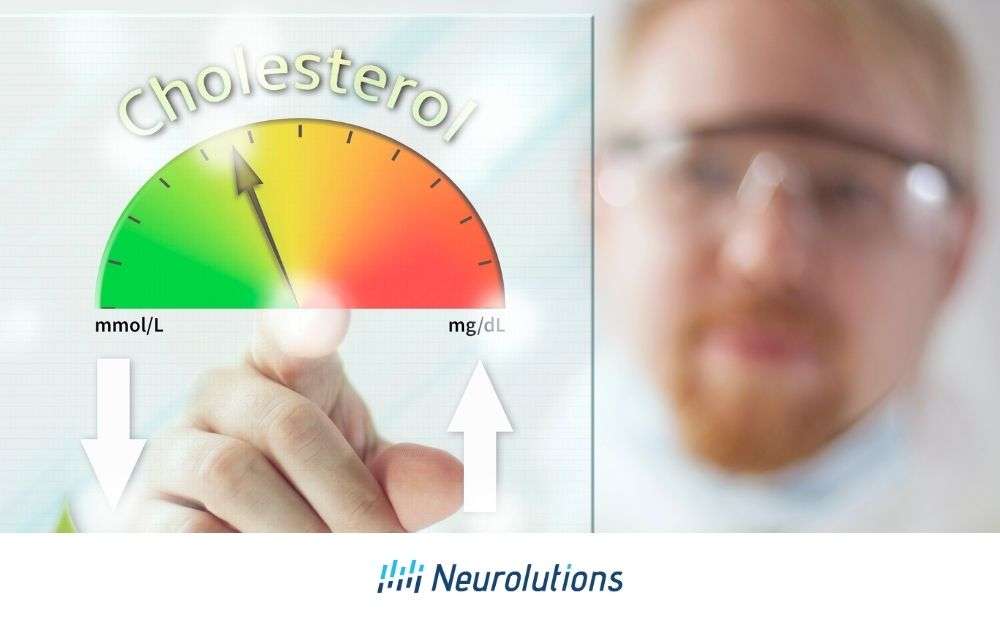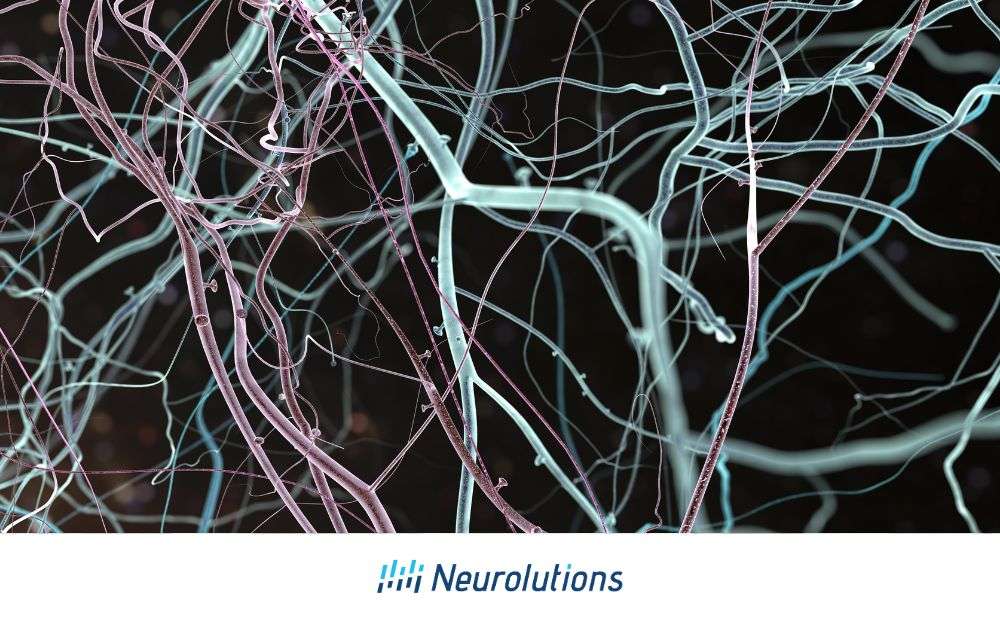Introduction
Cholesterol is a chemical substance made by the body and transported in the bloodstream, but it is also consumed in many commonly eaten food items. While cholesterol is necessary for the production of vitamins and for cellular health, it can also cause health problems when levels are too high. A higher-than-normal level of blood cholesterol often causes plaques to form in the arteries that can result in blood clots. In turn, this can increase the risk for a heart attack or stroke. Two out of every five adults in the US have high cholesterol (1).
This article describes the relationship between high cholesterol and both heart disease and other health disorders, the role of aging in the development of high cholesterol, how it is diagnosed and treated, and the role of diet and other lifestyle factors in keeping a cholesterol level within normal range.
Understanding the Different Types of Cholesterol and Their Impacts
Lipoproteins carry cholesterol and triglycerides through the bloodstream to cells in the body (2). There are two specific types of cholesterol measured by clinical lab tests.
The first type is called High-Density Lipoprotein (HDL). HDL is often called “good cholesterol” because it can prevent artery plaque build-up.
The second type is called Low-Density Lipoprotein (LDL). In contrast to HDL, this type of cholesterol causes plaque build-up in artery walls and can lead to one or more of the following potentially life-threatening disorders (3):
- Coronary Artery Disease (CAD) – plaque build-up in the arteries of the heart
- Carotid Artery Disease [or Stenosis] (CAS) – plaque build-up in the neck arteries, reducing or blocking blood flow to the brain;
- Peripheral Artery Disease (PAD) – plaque build-up in the arteries of the legs and/or arms or pelvis)
Relationship between Triglycerides and Cholesterol
Triglycerides are a type of fat that is carried in the blood. Triglycerides are consumed in foods, but also are generated by excess or unburned calories in the body that are stored as fat (4). A chronically-high triglyceride level in combination with a high cholesterol level tremendously increases the risk for heart attack or stroke (5).
In middle-age, metabolism in the cells of the body begins to slow, such that calories are not burned as quickly. Consequently, obesity and increased blood lipid levels of both cholesterol and triglycerides are more likely to occur in middle-aged adults who consumed high-fat diets in their younger adulthood.
Cholesterol’s Link to Heart Attack and Strokes – Why It is a Huge Risk Factor
The cholesterol plaque that forms and travels in the bloodstream can cause clots that prevent blood flow to the heart or brain. The cells in our bodies are nourished via the blood, thus, reduced or halted blood flow results in cellular death. When a clot occurs in a blood vessel leading to or in the heart, the result can be a heart attack. Likewise, when a clot occurs in a blood vessel leading to or in the brain, a stroke can be the result. More common than a stroke caused by bleeding in the brain would be an ischemic stroke, in which the underlying cause is a blot clot. These types of strokes account for 87% of all strokes (6).
For this reason, a person diagnosed with an abnormally high blood cholesterol and/or triglyceride level needs to take immediate action to lower that level. Generally speaking, the following are usually considered “good” cholesterol levels in healthy adults who are not obese (7):
- Total cholesterol level: Below 200 mg/dL (5.2 mmol/L).
- LDL cholesterol level: Below 130 mg/dL (3.4 mmol/L).
- HDL cholesterol level: Above 40 mg/dL (1 mmol/L) in men and above 50 mg/dL (1.3 mmol/L) in women.
What is Atherosclerosis and Why Does It Matter?
Atherosclerosis is the medical name for the health disorder in which plaque build-up occurs in the artery walls. It differs from arteriosclerosis, which can result from a variety of factors and is commonly known as “hardening of the arteries”. Atherosclerosis is typically a co-disorder in people living with arteriosclerosis.
The risk of developing atherosclerosis increases with age, with adults aged 60 and older at highest age-related risk. Problematically, symptoms of either arteriosclerosis or atherosclerosis do not occur until a severe diseased stage has been reached. Around 50% of all adults in the US who have atherosclerosis do not know it (8). Chest pain can be a symptom of atherosclerosis in the coronary arteries, while sudden weakness or numbness in one side of the body can be a symptom of this disorder in the carotid arteries (9). Unfortunately, a heart attack or stroke may be occurring by the time these atherosclerosis symptoms are experienced.
Top Risk Factors for High Cholesterol
Consuming high cholesterol foods on a daily basis, such as red meat, full-fat dairy products, and saturated fats, is a major risk factor for developing chronically-high cholesterol (10). Besides a rare genetic condition termed Familial Hypercholesterolemia that runs in families, the following are five other risk factors (11):
- Diabetes (Type 2)
- Obesity
- Elderly age
- Chronically-high blood pressure
- Lifestyle factors (such as a prolonged sedentary lifestyle, smoking, and alcohol or drug abuse)
A condition called Metabolic Syndrome, which is a cluster of metabolic abnormalities that often occurs in people with an overly high Body Mass Index (BMI), has been linked to the development of CAD (12). Therefore, chronically high cholesterol in a young adult living with Metabolic Syndrome requires urgent intervention to prevent a premature heart attack.
Diagnosing and Monitoring Cholesterol Levels
A person’s cholesterol level is determined by a lab test performed on a blood sample. As part of a routine annual physical examination, healthcare providers will usually refer their patients to have blood drawn in order to test for the level of various blood components.
The “Lipid Panel” testing normally determines the levels of the following:
- Total cholesterol
- LDL cholesterol
- HDL cholesterol
- Triglycerides
The Lipid Panel results usually specify the level of each of these four tested components and whether they are within normal range, low, or high. If total cholesterol, LDL cholesterol, and/or triglycerides are high, the healthcare provider will typically re-test the patient more frequently to monitor for changes. Reducing fat intake in the diet and losing weight may be effective in lowering total cholesterol and LDL cholesterol in some people, but taking cholesterol-lowering medication may be necessary for others. Monitoring the cholesterol levels of those taking cholesterol-lowering medications is necessary, because the cholesterol level may become too low such that the medication dosage needs to be reduced.
Preventing heart disease is a main reason that Lipid Panel blood testing is annually performed on adults, and reducing cholesterol levels is especially a priority for patients identified as having one or more other risk factors for developing heart disease.
A “Heart Healthy” Diet to Manage Cholesterol
Daily diets that are rich in vegetables and fruits have long been recommended to lower the risk of heart disease. Consumption of fat-free or low-fat dairy products is also recommended for a “heart healthy” diet. According to a research article in Vascular Health and Risk Management, three medically-recognized “heart healthy” diets are the Mediterranean, DASH, and plant-based diets (13). Reducing your intake of saturated and trans fats is crucial to a “heart healthy” diet, as well as lowering LDL cholesterol and triglyceride levels.
The Mayo Clinic includes the following among its heart healthy eating recommendations (14):
- Control your portion size
- Choose whole grains such as whole wheat bread
- Limit unhealthy fats (and avoid trans fats)
- Eat more fruits and vegetables
- Create daily menus so you can ensure eating meals that promote heart health
Lifestyle Changes and Medical Interventions
Obesity is so strongly-linked to an increased risk for heart disease that managing it is essential. This can take the form of increasing behaviors that promote activity and increased metabolism, engaging in a formal weight loss program, or bariatric surgery, if indicated. A Body Mass Index (BMI) that is 30 or higher, is considered to be in the clinical obesity range by healthcare providers (15). However, even a BMI of between 25-30 ,which is the overweight range, merits the management in daily calorie intake to prevent progressing to clinical obesity.
Since physical activity both burns calories and promotes heart health, switching from a sedentary lifestyle to one embracing daily exercise also is advisable. Lifestyle changes that reduce the likelihood of developing atherosclerosis and heart disease can lessen the likelihood of a heart attack or stroke. At least 20% of all heart disease fatalities are due to cigarette-smoking, so smoking cessation is a necessary lifestyle change to promote heart health (16).
In addition to high cholesterol, Diabetes (Type-2) is linked to both an increased risk for heart disease and stroke. If Pre-Diabetes is present in a patient, it is imperative to take steps that prevent progressing to full-blown Type-2 Diabetes. This can involve both changing daily diet and taking prescribed medication to lower the A1C.
Understanding Statin Medications:
The primary class of drugs aimed at controlling cholesterol are termed statins. Statins function by decreasing the amount of cholesterol produced by the liver, as well as assisting the liver to remove cholesterol from the blood (17). Statins are prescription medications, and the prescribed daily dose is aligned with the need based on lipid panel lab test results.
The first statin was approved by the FDA in 1987, and there are now a wide range of brands available for use (18). Not everyone with the same cholesterol level and same BMI will be prescribed the same daily statin dosage. Whatever the prescribed statin dose, this medication will need to be taken daily for life to control high cholesterol.
Some herbs, such as ginger, have been found in research studies to lower cholesterol, but taking herbal supplements to lower cholesterol can negatively interact with statins and their effectiveness (19, 20). Therefore, it is important for a patient to let their healthcare provider know they are using any herbal remedies on a regular basis to lower their cholesterol. For example, some statins negatively interact with grapefruit juice. Therefore, grapefruit juice may need to be removed from a diet if taking one of those statins (21).
Overall, utilizing a combined approach of diet, lifestyle, and medication is especially effective at lowering cholesterol to prevent heart disease or stroke. Since other factors can affect customary cholesterol and triglyceride levels, it is important to talk to a doctor about the best approach to prevent (or manage) high cholesterol and, thereby, reduce the risk for heart attack and/or stroke.
Living with High Cholesterol
There are no symptoms of high cholesterol, thus, people should have their fasting cholesterol level periodically checked by a healthcare provider. If a fasting cholesterol level is found to be high, a doctor may recommend taking daily statin medication. This is especially likely for middle-aged or senior-aged people.
If a young adult has received a clinical lab test result showing high cholesterol, it is crucial to take steps to lower cholesterol before reaching middle-age. Obesity is a major reason for high cholesterol levels and Pre-Diabetes in young adults. By engaging in a weight loss program, a young adult with a BMI of 25 or higher may be able to reverse the prediabetes and high cholesterol, thereby promoting heart health during middle-age and preventing a premature heart attack.
For people living with Familial Hypercholesterolemia, taking daily statin medication in tandem with dietary management may be imperative to control high cholesterol levels and prevent premature heart attack or stroke. The earlier that high cholesterol is brought under control to within a normal range, the less likely that it will cause atherosclerotic plaques to form. In turn, preventing atherosclerosis can promote better heart health in middle-age and later.
Conclusion
Cholesterol is produced by our bodies, but is also consumed in various foods in the daily diet. Meat, whole milk and other high fat dairy products, and saturated fats are the primary ways that we consume cholesterol in foods. In addition, many packaged and frozen foods contain high levels of cholesterol. Persistent high cholesterol is strongly linked to the later development of heart disease.
Plaque build-up in blood vessels resulting from high cholesterol can cause blood clots that travel through the bloodstream. These clots can reduce or halt blood flow to the heart and or brain resulting in a sudden heart attack or stroke.
Prevention is the key to preserving heart health. Switching to a daily diet that contains less cholesterol is a particularly “heart healthy” strategy. Besides eating a healthier diet, lifestyle changes such as maintaining weight within a normal range, shifting from a sedentary lifestyle to embracing regular daily exercise, and refraining from (or quitting) smoking are important approaches to lowering high cholesterol. Notably, these approaches promote both heart health and overall health and wellness.
Taking Action if You Have High Cholesterol is Key:
For anyone already diagnosed with high cholesterol, taking a daily statin medication, along with the above-described lifestyle changes, may be required to preserve health. Since obesity is highly-linked to developing high cholesterol and Diabetes (Type-2), engaging in a weight loss program or undergoing surgery for weight loss is important to lowering cholesterol and preventing an avoidable heart attack or stroke.
Total and LDL cholesterol levels tend to increase in adults as we age. Therefore, addressing high cholesterol levels as quickly as possible by embarking on health-promoting actions is a common-sense way to maintain heart health when entering middle-age or later life.
References:
- Centers for Disease Control (CDC). Know Your Risk for High Cholesterol. Webpage: https://www.cdc.gov/cholesterol/risk_factors.htm
- Cleveland Clinic [Cleveland, OH]. Lipoproteins. Webpage: https://my.clevelandclinic.org/health/articles/23229-lipoprotein
- National Heart, Lung, and Blood Institute (NHLBI). What is Atherosclerosis? Webpage: https://www.nhlbi.nih.gov/health/atherosclerosis
- National Heart, Lung, and Blood Institute (NHLBI). High Blood Triglycerides. Webpage: https://www.nhlbi.nih.gov/health/high-blood-triglycerides
- Toth PP, Granowitz C, Hull M, et al. (2018). High Triglycerides Are Associated With Increased Cardiovascular Events, Medical Costs, and Resource Use: A Real-World Administrative Claims Analysis of Statin-Treated Patients With High Residual Cardiovascular Risk. Journal of the American Heart Association 7(15): e008740. Webpage: https://www.ncbi.nlm.nih.gov/pmc/articles/PMC6201477/
- Johns Hopkins Medicine [Baltimore, MD]. Types of Stroke. Webpage: https://www.hopkinsmedicine.org/health/conditions-and-diseases/stroke/types-of-stroke
- InformedHealth.org [Internet]. (Updated 2017). High cholesterol: Overview. Institute for Quality and Efficiency in Health Care (IQWiG): Cologne, Germany. Webpage: https://www.ncbi.nlm.nih.gov/books/NBK279318/#:~:text=The%20following%20levels%20are%20considered,1.3%20mmol%2FL)%20in%20women
- National Heart, Lung, and Blood Institute (NHLBI). What is Atherosclerosis? Webpage: https://www.nhlbi.nih.gov/health/atherosclerosis
- Heart Research Institute (HRI). Atherosclerosis: causes and risk factors. Webpage: https://www.hri.org.au/health/learn/cardiovascular-disease/atherosclerosis-causes-and-risk-factors
- Cleveland Clinic [Cleveland, OH]. Cholesterol and Nutrition. Webpage: https://my.clevelandclinic.org/health/articles/16867-cholesterol–nutrition-tlc
- Centers for Disease Control (CDC). Know Your Risk for High Cholesterol. Webpage: https://www.cdc.gov/cholesterol/risk_factors.htm
- Blaton V. (2007). How is the Metabolic Syndrome Related to the Dyslipidemia? EJIFCC [The Journal of the International Federation of Clinical Chemistry and Laboratory Medicine] 18(1): 15-22. Webpage: https://www.ncbi.nlm.nih.gov/pmc/articles/PMC5875077/
- Diab A, Dastmalchi LN, Gulati M, et al. (2023). A Heart-Healthy Diet for Cardiovascular Disease Prevention: Where Are We Now? Vascular Health and Risk Management 19: 237-253. Webpage: https://www.ncbi.nlm.nih.gov/pmc/articles/PMC10128075/#:~:text=The%20Mediterranean%2C%20DASH%2C%20and%20healthy,risk%20of%20CVD%20and%20mortality.
- Mayo Clinic. Heart-healthy diet: 8 steps to prevent heart disease. Webpage: https://www.mayoclinic.org/diseases-conditions/heart-disease/in-depth/heart-healthy-diet/art-20047702
- Centers for Disease Control (CDC). Overweight and Obesity. Defining Adult Overweight & Obesity. Webpage: https://www.cdc.gov/obesity/basics/adult-defining.html#:~:text=If%20your%20BMI%20is%20less,falls%20within%20the%20obesity%20range.
- US Food and Drug Administration (FDA). How Smoking Affects Heart Health. Webpage: https://www.fda.gov/tobacco-products/health-effects-tobacco-use/how-smoking-affects-heart-health
- US Dept. of Health and Human Services (DHHS) [Million Hearts®]. The Scoop on Statins: What Do You Need to Know? Webpage: https://millionhearts.hhs.gov/learn-prevent/scoop-on-statins.html
- Harrington RA. (2017). Statins—Almost 30 Years of Use in the United States and Still Not Quite There. JAMA Cardiology2(1): 66. Webpage: https://jamanetwork.com/journals/jamacardiology/fullarticle/2583424
- Alizadeh-Navaei R, Roozbeh F, Saravi M, et al. (2008). Investigation of the effect of ginger on the lipid levels. A double blind controlled clinical trial. Saudi Medical Journal 29(9):1280-4. Webpage: https://pubmed.ncbi.nlm.nih.gov/18813412/
- Ongtanasup T, Prommee N, Jampa O, et al. (2022). The Cholesterol-Modulating Effect of the New Herbal Medicinal Recipe from Yellow Vine (Coscinium fenestratum(Goetgh), Ginger (Zingiber officinaleRoscoe), and Safflower (Carthamus tinctorius L.) on Suppressing PCSK9 Expression to Upregulate LDLR Expression in HepG2 Cells. Plants (Basel) 11(14): 1835. Webpage: https://www.ncbi.nlm.nih.gov/pmc/articles/PMC9318486/
- Harvard Health Publishing [Harvard Medical School]. (June 14, 2020). Grapefruit juice and statins. Webpage: https://www.health.harvard.edu/heart-health/grapefruit-juice-and-statins




